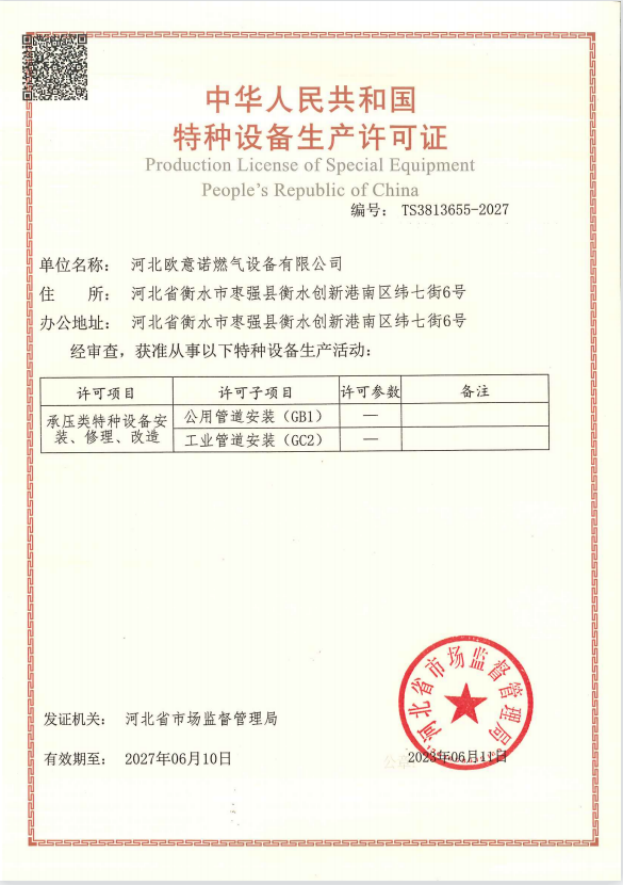
Nov . 29, 2024 11:59
Back to list
Pressure Management Strategies for Effective Regulation and Control
Understanding Pressure Regulation Systems
Pressure regulation systems play a vital role in various industrial applications, ensuring that processes operate smoothly and safely. Commonly found in industries such as oil and gas, chemical manufacturing, and water treatment, these systems help maintain optimal pressure levels within pipelines, tanks, and other equipment. This article explores the principles and importance of pressure regulation, the various types of pressure regulators, their components, and their applications.
Principles of Pressure Regulation
At its core, a pressure regulation system aims to control the pressure of a fluid—liquid or gas—to a predefined level. This is crucial because fluctuations in pressure can lead to equipment failure, safety hazards, and inefficient operation. Pressure regulators achieve this by using mechanical devices that adjust the flow of the medium based on real-time pressure readings.
The fundamental principle involves comparing the upstream pressure (the pressure before the regulator) with the desired downstream pressure (the pressure after the regulator). When upstream pressure exceeds the desired level, the regulator restricts the flow, allowing the downstream pressure to decrease. Conversely, if the upstream pressure drops, the regulator increases the flow to maintain the requisite pressure.
Types of Pressure Regulators
There are several types of pressure regulators used in different applications
1. Single-Stage Regulators These are simple devices that reduce high pressure to a lower level in one step. They are commonly used in applications where the required pressure is not highly variable.
2. Multi-Stage Regulators These regulators reduce pressure in multiple steps, which allows for more precise control. They are used in systems where maintaining a constant pressure is essential, such as in gas distribution networks.
3. Electronic Pressure Regulators Incorporating advanced technology, these regulators use sensors and microcontrollers to monitor and adjust pressure dynamically. They are ideal for applications where pressure stability is critical, such as in laboratory settings.
.
A typical pressure regulation system comprises several key components
مزلقة تنظيم الضغط

- Inlet and Outlet Ports These are the entry and exit points for the fluid, where the pressure is measured and adjusted.
- Diaphragm or Piston This component reacts to pressure changes. When the pressure exceeds the set point, the diaphragm or piston moves to throttle flow.
- Spring Springs are commonly used to apply a force against the diaphragm or piston. The tension of the spring determines the setpoint of the regulator.
- Adjustment Mechanism This allows operators to set the desired outlet pressure. It can be as simple as a screw mechanism or more complex with digital controls.
Applications of Pressure Regulators
Pressure regulation systems are versatile and find applications across various sectors
- Oil and Gas Industry Regulators manage the pressure within pipelines, ensuring safe transportation of natural gas and oil. Proper regulation prevents leaks and explosions.
- Chemical Manufacturing In chemical processes, maintaining specific pressure levels is crucial for reaction efficiency and safety. Regulators help control the pressure in reactors and pipelines.
- Water Treatment Pressure regulators maintain consistent water pressure in treatment facilities, ensuring effective filtration and chemical dosing.
- HVAC Systems These systems regulate air pressure to distribute heating and cooling effectively throughout buildings, improving comfort and energy efficiency.
Conclusion
In conclusion, pressure regulation systems are integral to many industrial processes, ensuring safety, efficiency, and reliability. Understanding their operation, types, components, and applications enables industries to select the right pressure regulation solutions tailored to their specific needs. As technology continues to advance, electronic and automated pressure regulators are likely to play an increasingly significant role, offering enhanced precision and control in diverse applications. These systems not only protect equipment and personnel but also contribute to the overall performance and productivity of industrial operations.
Latest news
-
Safety Valve Spring-Loaded Design Overpressure ProtectionNewsJul.25,2025
-
Precision Voltage Regulator AC5 Accuracy Grade PerformanceNewsJul.25,2025
-
Natural Gas Pressure Regulating Skid Industrial Pipeline ApplicationsNewsJul.25,2025
-
Natural Gas Filter Stainless Steel Mesh Element DesignNewsJul.25,2025
-
Gas Pressure Regulator Valve Direct-Acting Spring-Loaded DesignNewsJul.25,2025
-
Decompression Equipment Multi-Stage Heat Exchange System DesignNewsJul.25,2025

